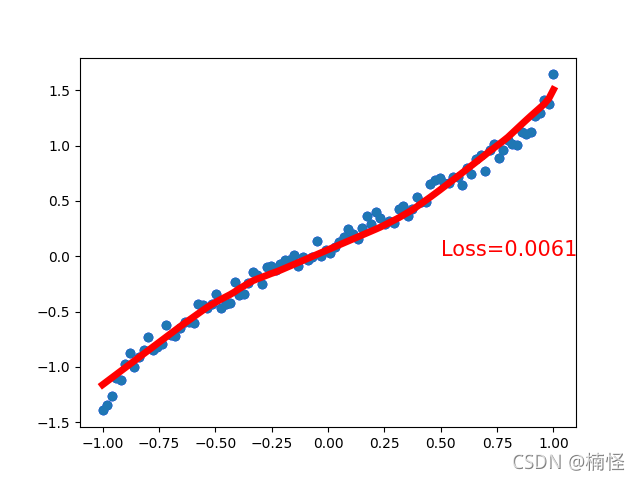拟合散点图
- 简单介绍
首先我们需要构造一些“假”的数据(即一些零散的点),主要的任务就是在这些假的数据点中拟合出一条曲线,使这条曲线尽可能地“穿过”所有的点。 - 制作数据集
我们在y=sin(x)+b这条曲线附近取一些点,使b具有随机性,因为在生活中大部分数据不可能精确到直接可以满足一条公式,基本所有的都是尽可能地去拟合数据。

import torch
import matplotlib.pyplot as plt
#制作假的数据集
x = torch.unsqueeze(torch.linspace(-1,1,100), dim=1)
y = torch.asin(x) + 0.2*torch.rand(x.size())
plt.scatter(x.data.numpy(), y.data.numpy())
plt.show()
- 搭建神经网络
这里的大概流程直接可以在pytorch的官方文档中找到,这是一份中文文档
具体搭建网络时需要继承torch中的Model类,类中主要有两个函数,init函数的作用是设置神经网络的每一层,即告诉我们每一层是干嘛的,都长啥样。而forward函数则相当于实战,传入数据,输出结果。
import torch
import torch.nn.functional as F
class Net(torch.nn.Module):
def __init__(self, n_features, hiddens, o_features):
#这一行代码可以不用管它到底是干什么的,只要知道如果要搭建网络必须这么干就完事
#如果非要搞懂,可以看一下下方的链接
#https://blog.csdn.net/wltsysterm/article/details/104440387
super(Net, self).__init__()
self.hidden = torch.nn.Linear(n_features, hiddens)
self.predict = torch.nn.Linear(hiddens, o_features)
def forward(self, x):
x = self.hidden(x)
x = F.relu(x)
x = self.predict(x)
return x
#构建一个网络
net = Net(n_features=1, hiddens=128, o_features=1)
print(net)
'''
Net(
(hidden): Linear(in_features=1, out_features=128, bias=True)
(predict): Linear(in_features=128, out_features=1, bias=True)
)
'''
- 训练网络
网络搭建好了,在训练网络之前,为了达到良好的效果,还需要选择适当的优化器,并且设置一些超参数,再选择合适的损失函数来表示误差,鉴定模型的优劣。最后通过循环不断将提前准备好的假数据喂给网络。
#设置优化器
optimizer = torch.optim.SGD(net.parameters(), lr=0.1)
#误差计算
loss_func = torch.nn.MSELoss()
#训练
for t in range(100):
#预测值
prediction = net(x)
loss = loss_func(prediction, y)
#清空梯度参数
optimizer.zero_grad()
#误差反向传播更新参数
loss.backward()
#更新网络参数
optimizer.step()
- 可视化拟合结果
为了能够直观的看出最后的拟合效果,将预测到的结果与原来的散点图绘制在一张图上。在这里经过多次训练选取了效果较好的一次展示。

#可视化最后拟合出来的曲线
plt.figure()
plt.scatter(x.data.numpy(), y.data.numpy(), color='blue')
plt.plot(x.data.numpy(), prediction.data.numpy(), 'r-', lw=5)
plt.text(0.5, 0, 'Loss=%.4f' % loss.data.numpy(), fontdict={'size': 15, 'color': 'red'})
plt.scatter(x.data.numpy(), y.data.numpy())
plt.show()
最后附上全部代码
import torch
import matplotlib.pyplot as plt
import torch.nn.functional as F
#制作假的数据集
x = torch.unsqueeze(torch.linspace(-1,1,100), dim=1)
y = torch.asin(x) + 0.2*torch.rand(x.size())
class Net(torch.nn.Module):
def __init__(self, n_features, hiddens, o_features):
#这一行代码可以不用管它到底是干什么的,只要知道如果要搭建网络必须这么干就完事
#如果非要搞懂,可以看一下本节下方的链接
super(Net, self).__init__()
self.hidden = torch.nn.Linear(n_features, hiddens)
self.predict = torch.nn.Linear(hiddens, o_features)
def forward(self, x):
x = self.hidden(x)
x = F.relu(x)
x = self.predict(x)
return x
#构建一个网络
net = Net(n_features=1, hiddens=128, o_features=1)
print(net)
'''
Net(
(hidden): Linear(in_features=1, out_features=128, bias=True)
(predict): Linear(in_features=128, out_features=1, bias=True)
)
'''
#设置优化器
optimizer = torch.optim.SGD(net.parameters(), lr=0.1)
#误差计算
loss_func = torch.nn.MSELoss()
#训练
for t in range(100):
#预测值
prediction = net(x)
loss = loss_func(prediction, y)
#清空梯度参数
optimizer.zero_grad()
#误差反向传播更新参数
loss.backward()
#更新网络参数
optimizer.step()
#可视化最后拟合出来的曲线
plt.figure()
plt.scatter(x.data.numpy(), y.data.numpy(), color='blue')
plt.plot(x.data.numpy(), prediction.data.numpy(), 'r-', lw=5)
plt.text(0.5, 0, 'Loss=%.4f' % loss.data.numpy(), fontdict={'size': 15, 'color': 'red'})
plt.scatter(x.data.numpy(), y.data.numpy())
plt.show()























 2388
2388











 被折叠的 条评论
为什么被折叠?
被折叠的 条评论
为什么被折叠?










